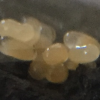Hello all! This is my first post on the forums. Glad to be here.
I got three different queens for you guys today.
Ant 1
1. Location (on a map) of collection: San Bernardino County, California. Found on my dining table as I was setting the dishes. It was night time about 10 PM.
2. Date of collection: July 2, 2017
3. Habitat of collection: Urban Chaparral, it's like almost a desert but not quite yet. Dry but still has shrubs and some greenery.
4. Length (from head to gaster): 5mm
5. Color, hue, pattern and texture: The whole ant was an even red when there is light.
6. Distinguishing characteristics: Two nodes, smooth thorax.
7. Distinguishing behavior: Kept pulling at the cotton to exit the first day. Shed wings the 2nd and is grooming herself.
8. Nest description: N/A
Ant 2
1. Location (on a map) of collection: San Bernardino County, California. Outside my home.
2. Date of collection: July 6, 2017
3. Habitat of collection: Urban Chaparral, it's like almost a desert but not quite yet. Dry but still has shrubs and some greenery.
4. Length (from head to gaster): 5mm
5. Color, hue, pattern and texture: The head was either dark brown or black. Thorax is brown. The abdomen is a shiny silver with light.
6. Distinguishing characteristics: Hard to tell if she doesn't have a node or has a very small one.
7. Distinguishing behavior: Very still, doesn't move much even during rough handling. Settled right in to test tube.
8. Nest description: Under a rock with moist soil underneath. There were two queens and a few dozen workers, no brood pile to be seen despite there being two queens. Found one larva being carried by a worker.

Queen 3
1. Location (on a map) of collection: Lytle Creek, California. Found in an outdoor firing range up in the mountains. The ground was dirt and gravel with large rocks. Found three in the morning, 9 AM, found one at 12 PM.
2. Date of collection: July 6, 2017
3. Habitat of collection: Mountain / Chaparral? Rocky area with bushes. It was a hot 102 degree day.
4. Length (from head to gaster): 10mm
5. Color, hue, pattern and texture: Red all throughout
6. Distinguishing characteristics: She clearly has one node with maybe a second node attached directly to the abdomen. Thorax is uneven with spikes on the back towards the abdomen. She has notable hairs in on where the abdominal segments connect.
7. Distinguishing behavior: Doesn't seem to settle in well to test tubes. All four queens are pulling at the cotton trying to get out. Seems to accept their death when they're in water. Moves fast across dirt and gravel. Was out and about during a hot day. It seems to have a stinger as it looks like it is trying to sting the cotton blocking the exit. The abdomen comes to a point at the tip leading me to believe she may have a stinger.
8. Nest description: N/A

Habitat :
Edited by Scrixx, July 6 2017 - 9:00 PM.

















